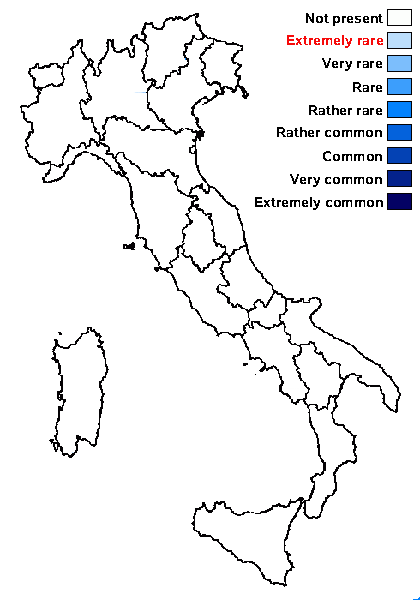Micarea herbarum M. Brand, Coppins, Sérus. & van den Boom
in van den Boom & al., Lichenologist 49: 20, 2017.
Synonyms:
Distribution:
Description: Thallus crustose, very thinly episubstratic, consisting of <0.1 mm wide, greenish, flattened or slightly convex areoles containing crystals visible under polarized light, often partly coated by a thin gelatinous film of green algal cells. Apothecia micareoid, emarginate, usually abundant, subglobose, 0.15-0.25 mm across, dark brown to black. Proper exciple not developed; epithecium with dark green-brown spots reacting K+ violet; hymenium colourless, c. 30-40 µm high; paraphyses sparse, branched, c. 1.2-1.4 µm thick at mid-level; hypothecium colourless. Asci 8-spored, clavate to cylindrical-clavate, in K/I with a blue outer layer and apical dome and unstained wall, the dome with an apical cushion, 20-28 x 7-12 µm. Ascospores 1-septate (rarely a few of them simple), hyaline, ellipsoid, 6.5-9.7 x 2-2.6 µm. Pycnidia sessile or immersed in thallus granules. Mesoconidia aseptate, hyaline, shortly bacilliform, rarely obovoid, 3.8-6.1 x 1–1.2(-1.3) µm. Photobiont micareoid, the cells 6-8 µm wide, thin-walled, clustered in compact masses. Spot tests: thallus K-, C-, KC- P-, UV-. Chemistry; thallus without lichen substances; apothecia with the Sedifolia-grey pigment.Note: A recently-described, inconspicuous and easily overlooked species growing on soft decaying wood, standing dead trunks, more rarely on dead and wet stems of herbaceous plants, known from a few sites in Eastern and Central Europe (Czarnota 2009). To be looked for in Italy.
Growth form: Crustose
Substrata: bark and lignum
Photobiont: green algae other than Trentepohlia
Reproductive strategy: mainly sexual

Predictive model
Growth form: Crustose
Substrata: bark and lignum
Photobiont: green algae other than Trentepohlia
Reproductive strategy: mainly sexual

Predictive model

